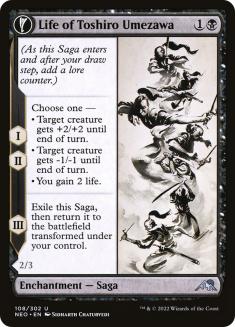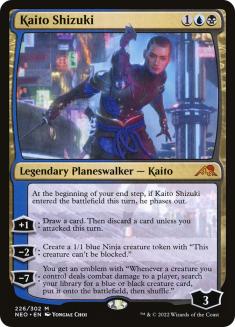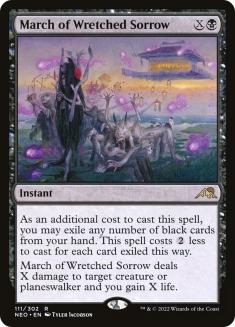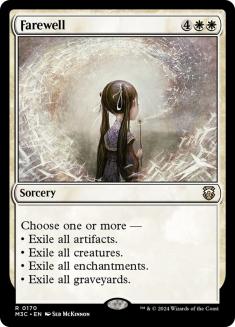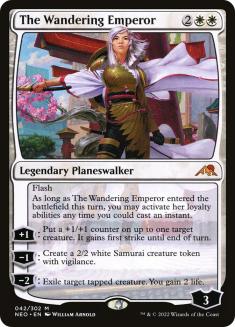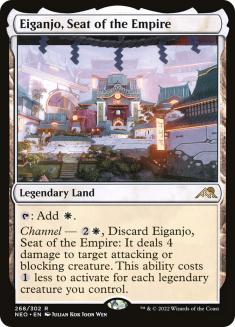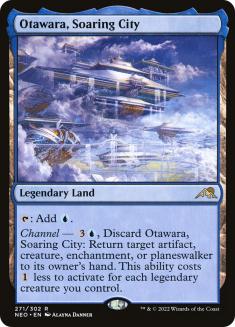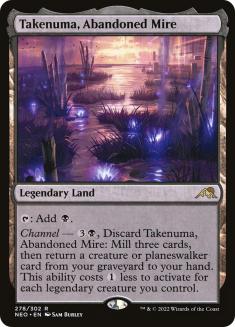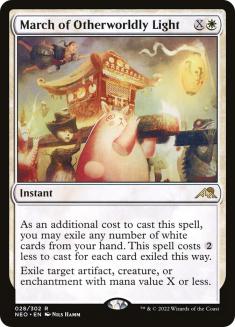It is good to be back in the swing of things. A short break in content creation is a great way to recharge the batteries and fuel the competitive drive for upcoming events. I have my eyes on SCG CON in Indianapolis, teaming with my pals Milan Bhayana and Dom Harvey, two young bucks who have graciously accepted to keep me on my toes in this Team Constructed event. With Milan, the youngest of the young bucks, on Legacy, and Dom on his pet format of Pioneer, I am very confident that we will have a strong showing. In Modern, I have no doubt that Azorius Control can do the job. The deck continues to improve in strength, put up strong finishes, and reward experience with results. The last point is the most important to me, as there is no shortage of deck experience in these veteran bones.
With Modern under control, I have spent more time playing Standard these days. I hate to say it, but the format is balanced for the first time in recent memory. Every event I play in has a bunch of different decks represented, across all spectrums of play. There are strong aggro, midrange, and control options for any mage to pick from. It is no surprise that I exist in the control aether, looking at the success of Azorius, Dimir, and Esper Control. Each of these decks has become more viable due to the strength of Kamigawa: Neon Dynasty, a set that has left its mark across the entire format. Let’s talk about the seven most revolutionary cards of the set for control and what to keep copies of for future play.
#7: Life of Toshiro Umezawa
Coming in seventh place is Life of Toshiro Umezawa. This type of effect is something I actively look for in every format and auto-include in every applicable control sideboard. Killing a creature and gaining some life is exactly what control needs to stay ahead of aggressive elements in newer formats. Control decks often struggle against aggro in Standard, Historic, and Alchemy because of ultimately losing the one-for-one battle. While control handles each threat, significant life loss takes place during each battle. Life of Toshiro Umezawa halts that issue, providing a removal spell, lifegain, and a further bonus that I am not used to having.
Once Life of Toshiro Umezawa kills a creature, it has a chance to kill an additional threat with even more life landing in the control coffers. This repeatable effect is another unique advantage to black-based control, joining The Meathook Massacre as my favorite enchantments to cast in Standard. After the second removal spell and four total life gained, it then becomes a creature, adding even more to its invested value. This creature has two power and three toughness, while having the ability to add mana for instant or sorcery spells. The only downside of Life of Toshiro Umezawa is that the opposing deck must summon one-toughness creature, but that is something white and red-based aggro loves to do. If those are in the format, this card will be in my sideboard.
#6: Kaito Shizuki
This set has gifted us multiple planeswalkers that will see competitive play. It is unusual to see that, especially in Standard, where the format has been hostile to control decks tapping out for a permanent with loyalty. After years of bannings, it seems that we can return to honest Magic, summoning planeswalkers, killing all the creatures, and drawing a bunch of cards. This play pattern is exactly what Richard Garfield intended, or that is at least what I tell myself all the time. Kaito Shizuki lands at number six on my list, but is arguably higher when examining the format outside of control’s lens.
Kaito Shizuki is a cheap planeswalker, hitting the battlefield for only three mana, and immediately defends itself by blinking out of existence for a turn. This protection occurs once it activates one of its abilities, both of which are very strong. Producing a creature, looting if an attack has not occurred, or drawing a card if an attack has occurred, is a strong set of options for a planeswalker of that mana value.
This card will play in control decks for that reason, but midrange players get the most bang for their buck. Control players have an issue applying pressure, taking full advantage of Kaito Shizuki’s draw engine. Although it produces unblockable creatures, the enemy simply aims its normally-dead removal at the tokens, weakening the impact of Kaito Shizuki. Even with this downside, it is still as strong card for control users and will be a part of my repertoire moving forward.
#5: March of Wretched Sorrow
This removal spell is one of my favorite in Standard and will possibly see play in Alchemy and Historic. March of Wretched Sorrow has some card disadvantage built in, but this does not affect its strength ranking. Many of the best control cards of all time require a sacrifice from the hand and see extensive play across all competitive formats. March of Wretched Sorrow is not a Solitude or Force of Will; however, it does give black-based control a powerful removal spell to thwart aggro decks in the newer formats.
Mono-Red and Mono-White Aggro are on the prowl again in Standard, joining the already-proven Mono-Green Aggro champion. All three of these decks can dish out tremendous damage, increasing the value of removal spells that have lifegain opportunities attached. March of Wretched Sorrow can be used in the late-game without penalty, fueling an obscenely large X and gaining that much life. It hits not only creatures but planeswalkers as well, giving it reach against more than just the blitz aggro decks we are terrified of.
This is the reason why March of Wretched Sorrow will likely see some play in older formats, providing versatility and competition to the more traditional black removal spells that only hit creatures. Having the opportunity to hit larger threats, while only having one mana available, is a theme that control decks will use in upcoming events.
#4: Farewell
Farewell is one I wanted to selfishly put much higher on my list. I love this card and what it does in Standard, Historic, and Alchemy, taking down all artifacts, creatures, enchantments, and graveyards. Farewell notably misses planeswalkers, making deckbuilding around it simple. This sweeper is selective, allowing the controller to choose what to take out, to maximize its effect on the opponent and avoid removing friendly permanents. The mana cost on this spell may scare off some people, but not me. The Expensive Sorcery blood runs through my veins, twenty years and going, prompting me to purchase a playset of this card once it was previewed.
One of the biggest perks of Farewell is that it exiles permanents. There are many strong sweepers in competitive Magic, even in Standard, requiring new members to set themselves apart to see play. The six-mana cost can be daunting to some; however, the effect it produces is well worth it. There are too many threats that have catastrophic abilities when they enter, and/or leave, the battlefield. Farewell prevents half of that nonsense and takes out graveyards as a safe measure. Doomskar and The Meathook Massacre are my first loves, but Farewell has officially earned a spot in my control heart.
#3: The Wandering Emperor
This is the best planeswalker for control in Kamigawa: Neon Dynasty. I knew it would be a big hitter in white-based control, as an instant-speed permanent that can activate its loyalty ability the turn it enters the battlefield. This play pattern is a game changer for control because it obliterates the traditional tap-out dilemma that planeswalkers usually bring with them.
Historically, control players commit to a Turn 4 planeswalker, hope it protects itself sufficiently, and pray the opponent does not perform a devastating act while their mana is temporarily exhausted. The Wandering Emperor protects itself by creating a Samurai creature token, whether cast as a sorcery or at instant speed on the opponent’s turn, earning Most Defensible in Its Class by a mile.
It is tough for me to play anything but white-based control because of The Wandering Emperor. I have gone back and forth between Azorius and Esper Control, but poor Dimir is far from my mind. The creature production by The Wandering Emperor is top-notch, but its largest impact is the initial removal effect it has.
The Wandering Emperor, when cast on the opponent’s turn, enters the battlefield, exiles a creature, and gains two life. At this point, it is too late to divert attackers to it, making it survive the onslaught and kill a big threat that was heading your way. The first ability does not assist the control plan much, but it does allow for use of additional tokens and removal effects down the road. The planeswalkers in this set have continued to impress me, and I hope more control-usable versions with flash hit the production line soon.
#2: Eiganjo, Seat of the Empire; Otawara, Soaring City; and Takenuma, Abandoned Mire
I had to cheat with my Top 7 list some, cramming all the lands into the #2 spot. Each of these lands will see play in control decks, across all competitive formats, due to their low opportunity cost. Each land enters the battlefield untapped and produces a primary color for the Esper shard. The downside is that they are legendary, meaning the number played in each deck will be under a full playset.
I have played at least two Eiganjo, Seat of the Empire in every white-based control deck, including Modern. Having additional removal spells seamlessly included in the manabase has been wonderful, turning flooded games into easy wins across the format roster. Otawara, Soaring City is a decent one-of in my lists, but has not had the impact that Eiganjo has had.
Takenuma, Abandoned Mire scratches the control archetypes some, but is much more effective in aggro or midrange decks. I play one in decks that use Lier, Disciple of the Drowned, since he is the key to victory in such decks. They depend on always having one on the battlefield and show significant weakness when trying to fend off threats with their one-for-one disruption package. Without Divide by Zero, Lier decks have had an uphill battle. The card is still bonkers and will see play; however, it will be more difficult to defend it. Therefore, Takenuma is an easy inclusion that will pay off big dividends.
#1: March of Otherworldly Light
One of the greatest removal spells of our generation has been gifted to us, and it is legal in Standard, Historic, Alchemy, and Pioneer. For the low price of one white mana, March of Otherworldly Light can exile any artifact, creature, or enchantment. The cost is the same as the March of Wretched Sorrow, requiring cards from hand or additional mana to be effective. Unlike the black version, it exiles and can hit problematic artifacts or enchantments, but not planeswalkers. This type of threat removal range moves it from a good card in Standard to something that can impact all competitive formats.
This was a no-brainer for my number one control card from Kamigawa: Neon Dynasty and the public seems to agree. I have already seen one- or two-ofs in white-based control decks in Modern, Pioneer, Historic, Alchemy, and Standard. This immediate incorporation brings joy to my heart, and this type of removal spell will not break the fabric of competitive Magic. It is good enough to see play, is reminiscent of the spells of old, and should be a green light for Studio X to take more risks in strong removal creation.
The issues in Magic (especially Standard) have been with problematic win conditions, not the removal that deals with them. These broken spells have been our downfall, not control’s pitiful attempt to answer them. This new set has brought me hope, with its beautiful design and flavor, that the Wizards of the Coast (WotC) crew is on the up-and-up. I will take another ten sets just like this, please!


